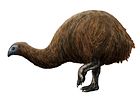
A ratite is any of a diverse group of mostly flightless, large and long-legged birds of the infraclass Palaeognathae. Kiwi, the exception, are much smaller and shorter-legged, as well as being the only nocturnal extant ratites.

Tinamous form an order of birds, comprising a single family with two distinct subfamilies, containing 46 species found in Mexico, Central America, and South America. The word "tinamou" comes from the Galibi term for these birds, tinamu. Tinamous have traditionally been regarded as the sister group of the flightless ratites, but recent work places them well within the ratite radiation, implying basal ratites could fly. Tinamous first appear in the fossil record in the Miocene epoch. They are generally sedentary, ground-dwelling and, though not flightless, when possible avoid flight in favour of hiding or running away from danger. They are found in a variety of habitats, ranging from semi-arid alpine grasslands to tropical rainforests. The two subfamilies are broadly divided by habitat, with the Nothurinae referred to as steppe or open country tinamous, and the Tinaminae known as forest tinamous.

Struthionidae is a family of flightless birds, containing the extant ostriches and their extinct relatives. The two extant species of ostrich are the common ostrich and Somali ostrich, both in the genus Struthio, which also contains several species known from Holocene fossils such as the Asian ostrich. The common ostrich is the more widespread of the two living species, and is the largest living bird species. Other ostriches are also among the largest bird species ever.

Rheidae is a family of flightless ratite birds which first appeared in the Paleocene. It is today represented by the sole living genus Rhea, but also contains several extinct genera.

Gastornis is an extinct genus of large flightless birds that lived during the late Paleocene and Eocene epochs of the Cenozoic era. The genus is currently thought to contain three or four distinct species, known from incomplete fossil remains, found in western-central Europe. More complete specimens are known from a fourth, North American species, which had previously been classified in the distinct genus Diatryma. Many scientists now consider Diatryma to be so similar to the other species of Gastornis that it should also be included in that genus. A fifth species, also previously classified in its own genus, is known from China.

Flightless birds are birds that through evolution lost the ability to fly. There are over 60 extant species, including the well known ratites and penguins. The smallest flightless bird is the Inaccessible Island rail. The largest flightless bird, which is also the largest living bird, is the ostrich.

Struthio is a genus of birds in the order Struthioniformes, whose members are the ostriches. It is part of the infra-class Palaeognathae, a diverse group of flightless birds also known as ratites that includes the emus, rheas, and kiwis. There are two living species of ostrich, the common ostrich and the Somali ostrich. They are large flightless birds of Africa who lay the largest eggs of any living land animal. With the ability to run at 70 km/h (43.5 mph), they are the fastest birds on land. It is farmed worldwide, particularly for its feathers as they are used as decoration and feather dusters. Its skin is also used for leather products.

Palaeognathae, or paleognaths is one of 2 living clades of birds – the other being Neognathae. Together, these two clades form the clade Neornithes. Palaeognathae contains five extant branches of flightless lineages, termed ratites, and one flying lineage, the Neotropic tinamous. There are 47 species of tinamous, 5 of kiwis (Apteryx), 3 of cassowaries (Casuarius), 1 of emus (Dromaius), 2 of rheas (Rhea) and 2 of ostrich (Struthio). Recent research has indicated that paleognaths are monophyletic but the traditional taxonomic split between flightless and flighted forms is incorrect; tinamous are within the ratite radiation, meaning flightlessness arose independently multiple times via parallel evolution.

Gastornithidae is a family of prehistoric birds. The various species in this group lived from the Paleocene to the Eocene epochs and ranged from Asia and Europe to North America. All known species were very large, flightless ground birds, similar to ostriches but more heavily built and with huge beaks. Once thought to be carnivores, they are now considered to have been primarily herbivorous.

Palaeotis is a genus of paleognath birds from the middle Eocene epoch of central Europe. One species is known, Palaeotis weigelti. The holotype specimen is a fossil tarsometatarsus and phalanx. Lambrect (1928) described it as an extinct bustard, and gave it its consequent name. After a suggestion by Storrs L. Olson, a review of the type specimen and the referral of several other fossils by Houde and Haubold (1987) concluded that Palaeotis is a palaeognath and assigned it to the same order as ostriches; the Struthioniformes.

Walbeck is a village and a former municipality in the Börde district in Saxony-Anhalt, Germany. Since 1 January 2010, it is part of the town Oebisfelde-Weferlingen.
Diogenornis is an extinct genus of ratites, that lived during the Early Eocene. It was described in 1983 by Brazilian scientist Herculano Marcos Ferraz de Alvarenga based on fossils found in the Itaboraí Formation. The type species is D. fragilis. While initially considered a member of the family Opisthodactylidae, further examination of the fossil remains showed that it was more similar to the modern rhea. According to Gerald Mayr, Diogenornis is best considered a stem-group member of the Rheidae. It grew to about two thirds the size of the modern greater rhea, at about 90 centimetres (3.0 ft) of height.

Lithornis is a genus of extinct paleognathous birds. Lithornis were able to fly well, but are closely related to today's tinamous and ratites.

Lithornithidae is an extinct, possibly paraphyletic clade of early paleognath birds. They are known from fossils dating to the Upper Paleocene through the Middle Eocene of North America and Europe, with possible Late Cretaceous representatives. All are extinct today; the youngest specimen is the currently unnamed SGPIMH MEV1 specimen from the mid-Eocene Messel Pit site.
Eremopezus is a prehistoric bird genus, possibly a palaeognath. It is known only from the fossil remains of a single species, the huge and presumably flightless Eremopezus eocaenus. This was found in Upper Eocene Jebel Qatrani Formation deposits around the Qasr el Sagha escarpment, north of the Birket Qarun lake near Faiyum in Egypt. The rocks its fossils occur in were deposited in the Priabonian, with the oldest dating back to about 36 million years ago (Ma) and the youngest not less than about 33 Ma.

Mentoclaenodon is an extinct genus of arctocyonid ungulate mammals.
Qinornis is a prehistoric bird genus from the early-mid-Paleocene epoch, about 61 million years ago. It is known from a single fossil specimen consisting of a partial hind limb and foot, which was found in Fangou Formation deposits in Luonan County, China.
Remiornis heberti is an extinct species of paleognath bird from the Paleocene of France. It is a species comparable in size to modern rheas, and possibly related to another European Paleogene ratite, Palaeotis. In spite of being one of the oldest ratites in the world, it is often ignored for Gondwana vicariance narratives.
Elaphrocnemus is a genus of extinct bird from the Eocene and Oligocene periods of Europe. Part of Cariamiformes, its closest living relatives are seriemas, though it differs significantly from them, being a better flyer.
Calciavis is an extinct genus of bird from the Eocene of Wyoming. It is a lithornithid, a member of a lineage of flying palaeognaths, distantly related to modern ratites. Like many other fossils from the Green River Formation, it is exceptionally well preserved, bearing soft-tissue impressions of skin and feathers.















